Analyzing Employee Engagement in Employee-Owned Organizations
VerifiedAdded on 2020/04/21
|11
|2285
|125
AI Summary
The research explores employee engagement within employee-owned organizations, identifying key influencing factors. The study uses a qualitative approach with interviews and observations from 10 companies. Data analysis focuses on organizational structures, communication strategies, and cultural practices that enhance engagement. Despite limitations like sample size, the findings provide valuable insights for future research in enhancing engagement in similar settings.
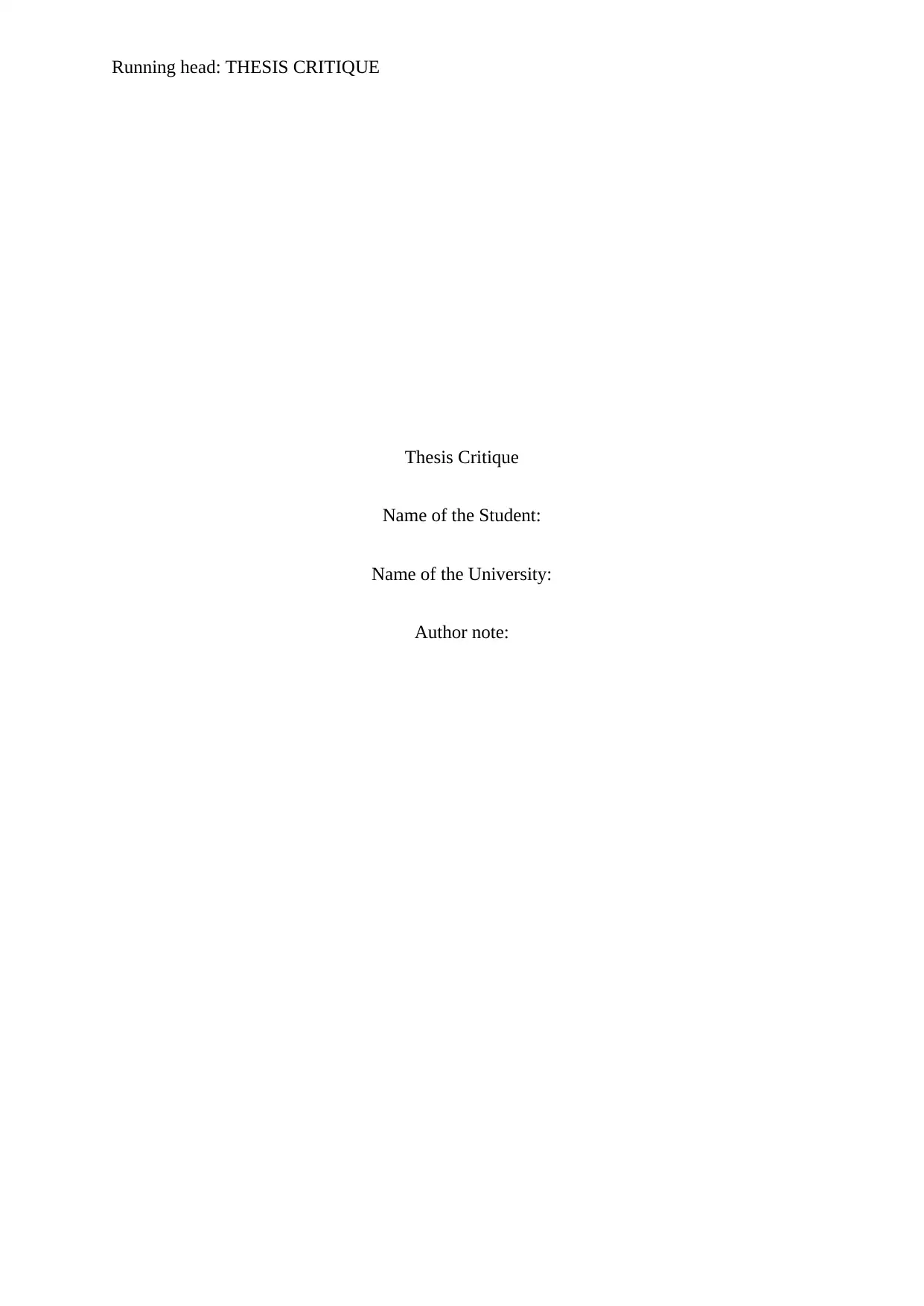
Running head: THESIS CRITIQUE
Thesis Critique
Name of the Student:
Name of the University:
Author note:
Thesis Critique
Name of the Student:
Name of the University:
Author note:
Paraphrase This Document
Need a fresh take? Get an instant paraphrase of this document with our AI Paraphraser

1THESIS CRITIQUE
Table of Contents
Abstract......................................................................................................................................2
Introduction................................................................................................................................3
Purpose and Objectives of the Study.........................................................................................3
Theoretical Framework..............................................................................................................4
Situating the Study within the research......................................................................................5
Research Approach....................................................................................................................6
Research Methodology...............................................................................................................7
Presentation and analysis of the results......................................................................................8
Conclusion..................................................................................................................................8
References................................................................................................................................10
Bibliography.............................................................................................................................10
Table of Contents
Abstract......................................................................................................................................2
Introduction................................................................................................................................3
Purpose and Objectives of the Study.........................................................................................3
Theoretical Framework..............................................................................................................4
Situating the Study within the research......................................................................................5
Research Approach....................................................................................................................6
Research Methodology...............................................................................................................7
Presentation and analysis of the results......................................................................................8
Conclusion..................................................................................................................................8
References................................................................................................................................10
Bibliography.............................................................................................................................10

2THESIS CRITIQUE
Abstract
The article “Employee ownership: Evaluating the Factors Contributing to Successful
Employee Engagement” written by Professor Heather Jayne Rowley explores the role of
employees in employee owned organizations. The interpretative study deals with the
employee engagement and several factors contributing to the successful engagement of
employees. The research approach is qualitative and several data is collected from interviews
and surveys along with available information from the internet. In the report, discussion
regarding theoretical framework, analysis, main findings and research questions are done.
Key Words: Employee, Ownership, Organization, Interpretative approach, Theoretical
Framework.
Abstract
The article “Employee ownership: Evaluating the Factors Contributing to Successful
Employee Engagement” written by Professor Heather Jayne Rowley explores the role of
employees in employee owned organizations. The interpretative study deals with the
employee engagement and several factors contributing to the successful engagement of
employees. The research approach is qualitative and several data is collected from interviews
and surveys along with available information from the internet. In the report, discussion
regarding theoretical framework, analysis, main findings and research questions are done.
Key Words: Employee, Ownership, Organization, Interpretative approach, Theoretical
Framework.
⊘ This is a preview!⊘
Do you want full access?
Subscribe today to unlock all pages.

Trusted by 1+ million students worldwide
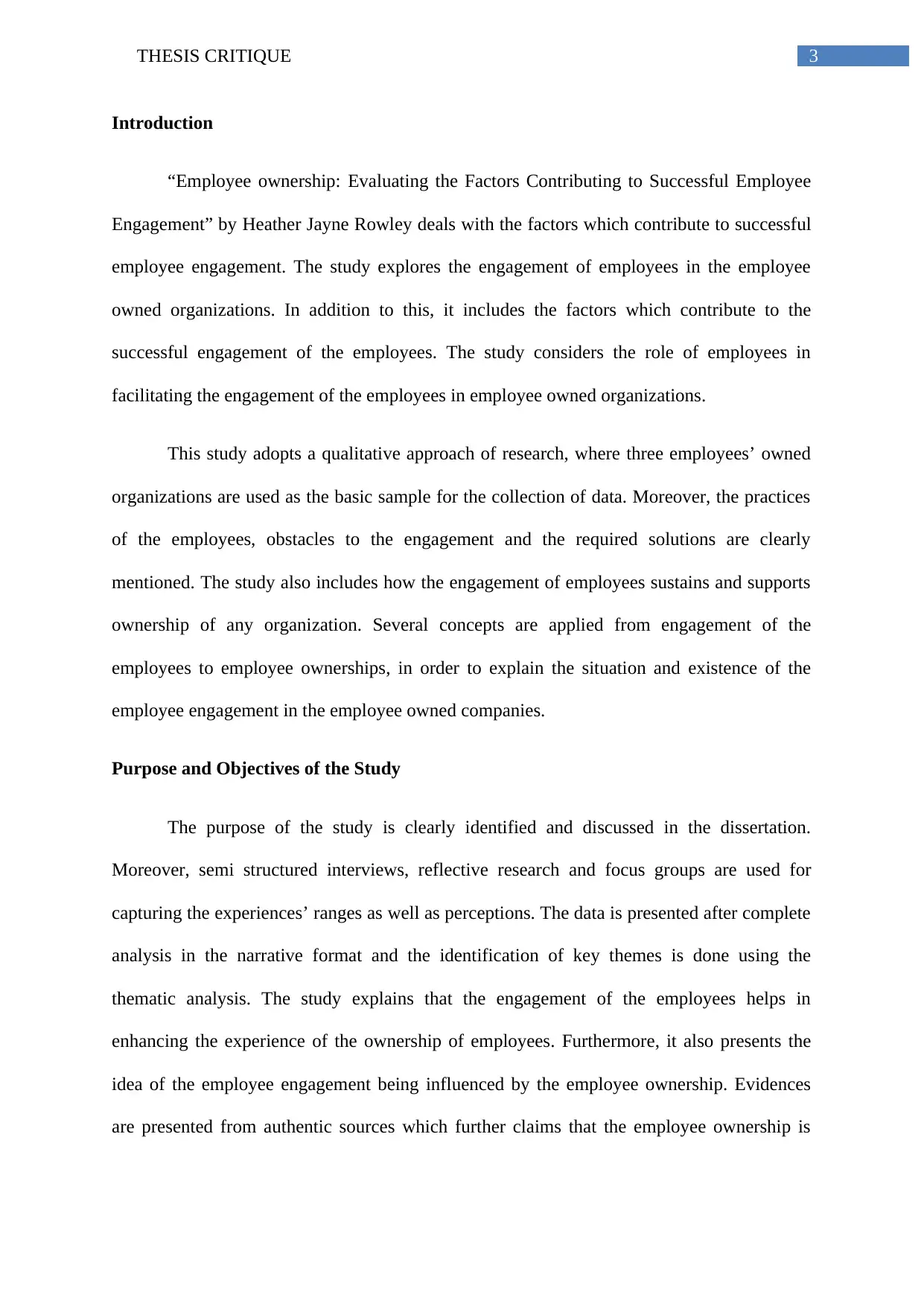
3THESIS CRITIQUE
Introduction
“Employee ownership: Evaluating the Factors Contributing to Successful Employee
Engagement” by Heather Jayne Rowley deals with the factors which contribute to successful
employee engagement. The study explores the engagement of employees in the employee
owned organizations. In addition to this, it includes the factors which contribute to the
successful engagement of the employees. The study considers the role of employees in
facilitating the engagement of the employees in employee owned organizations.
This study adopts a qualitative approach of research, where three employees’ owned
organizations are used as the basic sample for the collection of data. Moreover, the practices
of the employees, obstacles to the engagement and the required solutions are clearly
mentioned. The study also includes how the engagement of employees sustains and supports
ownership of any organization. Several concepts are applied from engagement of the
employees to employee ownerships, in order to explain the situation and existence of the
employee engagement in the employee owned companies.
Purpose and Objectives of the Study
The purpose of the study is clearly identified and discussed in the dissertation.
Moreover, semi structured interviews, reflective research and focus groups are used for
capturing the experiences’ ranges as well as perceptions. The data is presented after complete
analysis in the narrative format and the identification of key themes is done using the
thematic analysis. The study explains that the engagement of the employees helps in
enhancing the experience of the ownership of employees. Furthermore, it also presents the
idea of the employee engagement being influenced by the employee ownership. Evidences
are presented from authentic sources which further claims that the employee ownership is
Introduction
“Employee ownership: Evaluating the Factors Contributing to Successful Employee
Engagement” by Heather Jayne Rowley deals with the factors which contribute to successful
employee engagement. The study explores the engagement of employees in the employee
owned organizations. In addition to this, it includes the factors which contribute to the
successful engagement of the employees. The study considers the role of employees in
facilitating the engagement of the employees in employee owned organizations.
This study adopts a qualitative approach of research, where three employees’ owned
organizations are used as the basic sample for the collection of data. Moreover, the practices
of the employees, obstacles to the engagement and the required solutions are clearly
mentioned. The study also includes how the engagement of employees sustains and supports
ownership of any organization. Several concepts are applied from engagement of the
employees to employee ownerships, in order to explain the situation and existence of the
employee engagement in the employee owned companies.
Purpose and Objectives of the Study
The purpose of the study is clearly identified and discussed in the dissertation.
Moreover, semi structured interviews, reflective research and focus groups are used for
capturing the experiences’ ranges as well as perceptions. The data is presented after complete
analysis in the narrative format and the identification of key themes is done using the
thematic analysis. The study explains that the engagement of the employees helps in
enhancing the experience of the ownership of employees. Furthermore, it also presents the
idea of the employee engagement being influenced by the employee ownership. Evidences
are presented from authentic sources which further claims that the employee ownership is
Paraphrase This Document
Need a fresh take? Get an instant paraphrase of this document with our AI Paraphraser
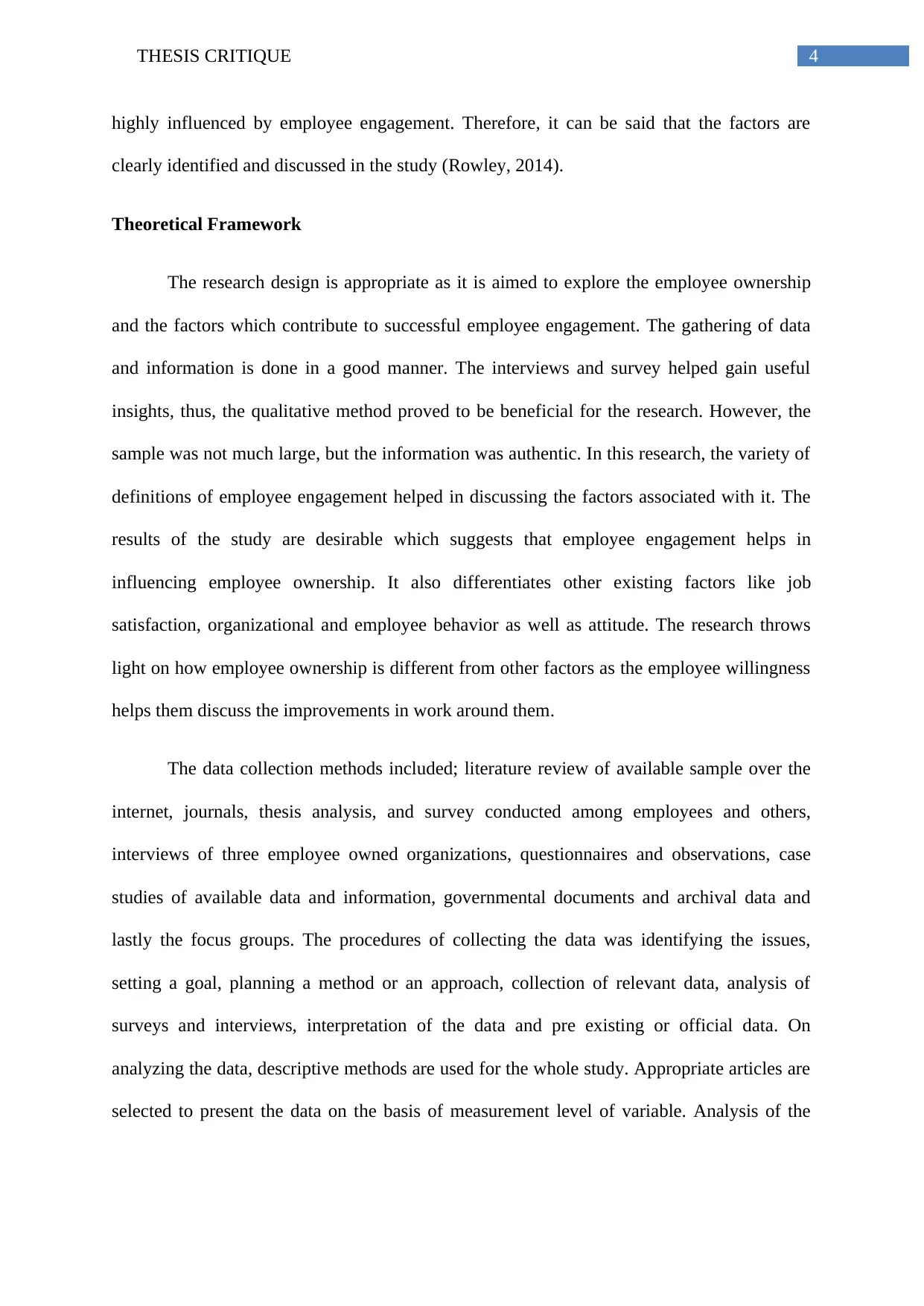
4THESIS CRITIQUE
highly influenced by employee engagement. Therefore, it can be said that the factors are
clearly identified and discussed in the study (Rowley, 2014).
Theoretical Framework
The research design is appropriate as it is aimed to explore the employee ownership
and the factors which contribute to successful employee engagement. The gathering of data
and information is done in a good manner. The interviews and survey helped gain useful
insights, thus, the qualitative method proved to be beneficial for the research. However, the
sample was not much large, but the information was authentic. In this research, the variety of
definitions of employee engagement helped in discussing the factors associated with it. The
results of the study are desirable which suggests that employee engagement helps in
influencing employee ownership. It also differentiates other existing factors like job
satisfaction, organizational and employee behavior as well as attitude. The research throws
light on how employee ownership is different from other factors as the employee willingness
helps them discuss the improvements in work around them.
The data collection methods included; literature review of available sample over the
internet, journals, thesis analysis, and survey conducted among employees and others,
interviews of three employee owned organizations, questionnaires and observations, case
studies of available data and information, governmental documents and archival data and
lastly the focus groups. The procedures of collecting the data was identifying the issues,
setting a goal, planning a method or an approach, collection of relevant data, analysis of
surveys and interviews, interpretation of the data and pre existing or official data. On
analyzing the data, descriptive methods are used for the whole study. Appropriate articles are
selected to present the data on the basis of measurement level of variable. Analysis of the
highly influenced by employee engagement. Therefore, it can be said that the factors are
clearly identified and discussed in the study (Rowley, 2014).
Theoretical Framework
The research design is appropriate as it is aimed to explore the employee ownership
and the factors which contribute to successful employee engagement. The gathering of data
and information is done in a good manner. The interviews and survey helped gain useful
insights, thus, the qualitative method proved to be beneficial for the research. However, the
sample was not much large, but the information was authentic. In this research, the variety of
definitions of employee engagement helped in discussing the factors associated with it. The
results of the study are desirable which suggests that employee engagement helps in
influencing employee ownership. It also differentiates other existing factors like job
satisfaction, organizational and employee behavior as well as attitude. The research throws
light on how employee ownership is different from other factors as the employee willingness
helps them discuss the improvements in work around them.
The data collection methods included; literature review of available sample over the
internet, journals, thesis analysis, and survey conducted among employees and others,
interviews of three employee owned organizations, questionnaires and observations, case
studies of available data and information, governmental documents and archival data and
lastly the focus groups. The procedures of collecting the data was identifying the issues,
setting a goal, planning a method or an approach, collection of relevant data, analysis of
surveys and interviews, interpretation of the data and pre existing or official data. On
analyzing the data, descriptive methods are used for the whole study. Appropriate articles are
selected to present the data on the basis of measurement level of variable. Analysis of the
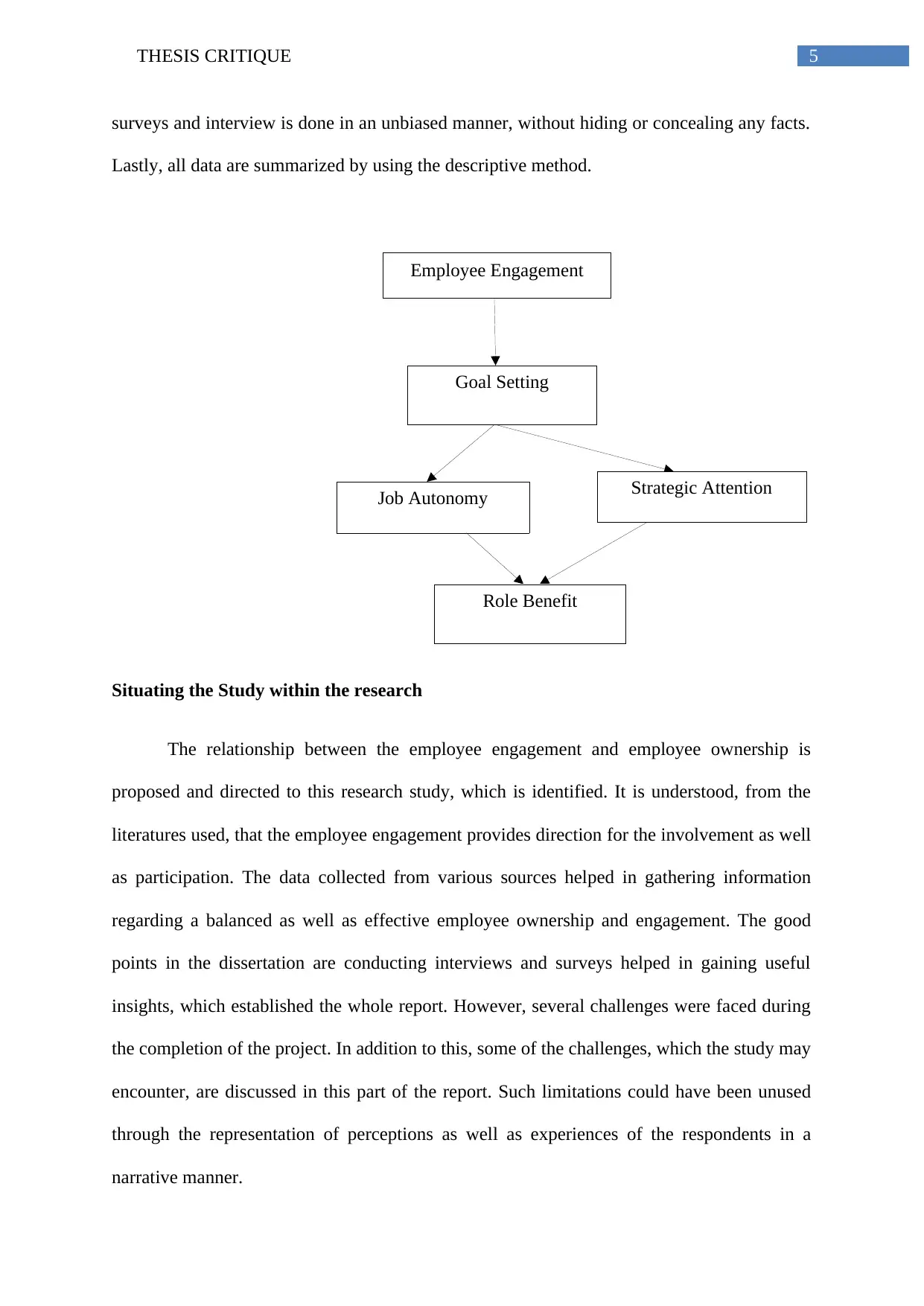
5THESIS CRITIQUE
surveys and interview is done in an unbiased manner, without hiding or concealing any facts.
Lastly, all data are summarized by using the descriptive method.
Situating the Study within the research
The relationship between the employee engagement and employee ownership is
proposed and directed to this research study, which is identified. It is understood, from the
literatures used, that the employee engagement provides direction for the involvement as well
as participation. The data collected from various sources helped in gathering information
regarding a balanced as well as effective employee ownership and engagement. The good
points in the dissertation are conducting interviews and surveys helped in gaining useful
insights, which established the whole report. However, several challenges were faced during
the completion of the project. In addition to this, some of the challenges, which the study may
encounter, are discussed in this part of the report. Such limitations could have been unused
through the representation of perceptions as well as experiences of the respondents in a
narrative manner.
Employee Engagement
Goal Setting
Job Autonomy Strategic Attention
Role Benefit
surveys and interview is done in an unbiased manner, without hiding or concealing any facts.
Lastly, all data are summarized by using the descriptive method.
Situating the Study within the research
The relationship between the employee engagement and employee ownership is
proposed and directed to this research study, which is identified. It is understood, from the
literatures used, that the employee engagement provides direction for the involvement as well
as participation. The data collected from various sources helped in gathering information
regarding a balanced as well as effective employee ownership and engagement. The good
points in the dissertation are conducting interviews and surveys helped in gaining useful
insights, which established the whole report. However, several challenges were faced during
the completion of the project. In addition to this, some of the challenges, which the study may
encounter, are discussed in this part of the report. Such limitations could have been unused
through the representation of perceptions as well as experiences of the respondents in a
narrative manner.
Employee Engagement
Goal Setting
Job Autonomy Strategic Attention
Role Benefit
⊘ This is a preview!⊘
Do you want full access?
Subscribe today to unlock all pages.

Trusted by 1+ million students worldwide
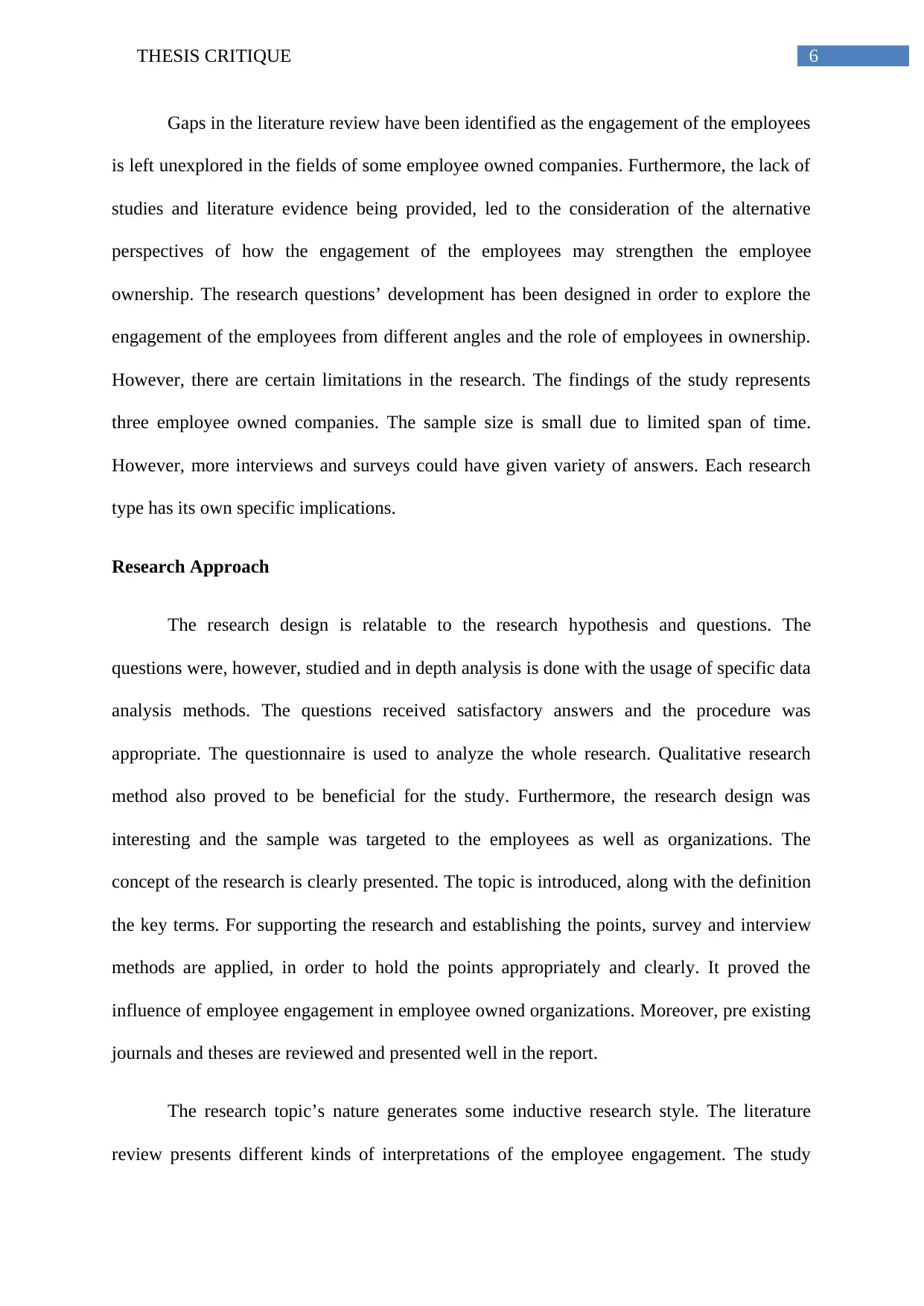
6THESIS CRITIQUE
Gaps in the literature review have been identified as the engagement of the employees
is left unexplored in the fields of some employee owned companies. Furthermore, the lack of
studies and literature evidence being provided, led to the consideration of the alternative
perspectives of how the engagement of the employees may strengthen the employee
ownership. The research questions’ development has been designed in order to explore the
engagement of the employees from different angles and the role of employees in ownership.
However, there are certain limitations in the research. The findings of the study represents
three employee owned companies. The sample size is small due to limited span of time.
However, more interviews and surveys could have given variety of answers. Each research
type has its own specific implications.
Research Approach
The research design is relatable to the research hypothesis and questions. The
questions were, however, studied and in depth analysis is done with the usage of specific data
analysis methods. The questions received satisfactory answers and the procedure was
appropriate. The questionnaire is used to analyze the whole research. Qualitative research
method also proved to be beneficial for the study. Furthermore, the research design was
interesting and the sample was targeted to the employees as well as organizations. The
concept of the research is clearly presented. The topic is introduced, along with the definition
the key terms. For supporting the research and establishing the points, survey and interview
methods are applied, in order to hold the points appropriately and clearly. It proved the
influence of employee engagement in employee owned organizations. Moreover, pre existing
journals and theses are reviewed and presented well in the report.
The research topic’s nature generates some inductive research style. The literature
review presents different kinds of interpretations of the employee engagement. The study
Gaps in the literature review have been identified as the engagement of the employees
is left unexplored in the fields of some employee owned companies. Furthermore, the lack of
studies and literature evidence being provided, led to the consideration of the alternative
perspectives of how the engagement of the employees may strengthen the employee
ownership. The research questions’ development has been designed in order to explore the
engagement of the employees from different angles and the role of employees in ownership.
However, there are certain limitations in the research. The findings of the study represents
three employee owned companies. The sample size is small due to limited span of time.
However, more interviews and surveys could have given variety of answers. Each research
type has its own specific implications.
Research Approach
The research design is relatable to the research hypothesis and questions. The
questions were, however, studied and in depth analysis is done with the usage of specific data
analysis methods. The questions received satisfactory answers and the procedure was
appropriate. The questionnaire is used to analyze the whole research. Qualitative research
method also proved to be beneficial for the study. Furthermore, the research design was
interesting and the sample was targeted to the employees as well as organizations. The
concept of the research is clearly presented. The topic is introduced, along with the definition
the key terms. For supporting the research and establishing the points, survey and interview
methods are applied, in order to hold the points appropriately and clearly. It proved the
influence of employee engagement in employee owned organizations. Moreover, pre existing
journals and theses are reviewed and presented well in the report.
The research topic’s nature generates some inductive research style. The literature
review presents different kinds of interpretations of the employee engagement. The study
Paraphrase This Document
Need a fresh take? Get an instant paraphrase of this document with our AI Paraphraser
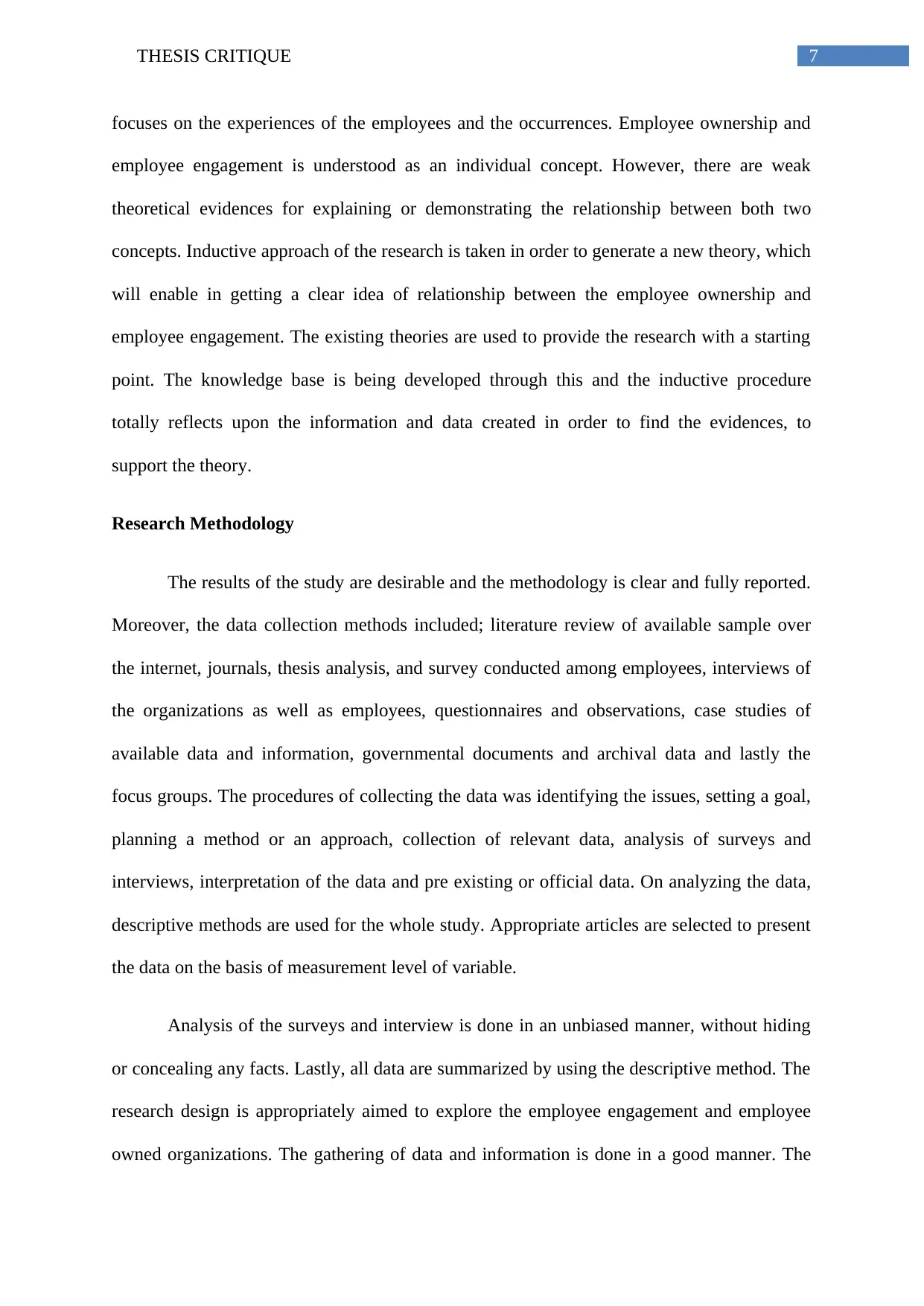
7THESIS CRITIQUE
focuses on the experiences of the employees and the occurrences. Employee ownership and
employee engagement is understood as an individual concept. However, there are weak
theoretical evidences for explaining or demonstrating the relationship between both two
concepts. Inductive approach of the research is taken in order to generate a new theory, which
will enable in getting a clear idea of relationship between the employee ownership and
employee engagement. The existing theories are used to provide the research with a starting
point. The knowledge base is being developed through this and the inductive procedure
totally reflects upon the information and data created in order to find the evidences, to
support the theory.
Research Methodology
The results of the study are desirable and the methodology is clear and fully reported.
Moreover, the data collection methods included; literature review of available sample over
the internet, journals, thesis analysis, and survey conducted among employees, interviews of
the organizations as well as employees, questionnaires and observations, case studies of
available data and information, governmental documents and archival data and lastly the
focus groups. The procedures of collecting the data was identifying the issues, setting a goal,
planning a method or an approach, collection of relevant data, analysis of surveys and
interviews, interpretation of the data and pre existing or official data. On analyzing the data,
descriptive methods are used for the whole study. Appropriate articles are selected to present
the data on the basis of measurement level of variable.
Analysis of the surveys and interview is done in an unbiased manner, without hiding
or concealing any facts. Lastly, all data are summarized by using the descriptive method. The
research design is appropriately aimed to explore the employee engagement and employee
owned organizations. The gathering of data and information is done in a good manner. The
focuses on the experiences of the employees and the occurrences. Employee ownership and
employee engagement is understood as an individual concept. However, there are weak
theoretical evidences for explaining or demonstrating the relationship between both two
concepts. Inductive approach of the research is taken in order to generate a new theory, which
will enable in getting a clear idea of relationship between the employee ownership and
employee engagement. The existing theories are used to provide the research with a starting
point. The knowledge base is being developed through this and the inductive procedure
totally reflects upon the information and data created in order to find the evidences, to
support the theory.
Research Methodology
The results of the study are desirable and the methodology is clear and fully reported.
Moreover, the data collection methods included; literature review of available sample over
the internet, journals, thesis analysis, and survey conducted among employees, interviews of
the organizations as well as employees, questionnaires and observations, case studies of
available data and information, governmental documents and archival data and lastly the
focus groups. The procedures of collecting the data was identifying the issues, setting a goal,
planning a method or an approach, collection of relevant data, analysis of surveys and
interviews, interpretation of the data and pre existing or official data. On analyzing the data,
descriptive methods are used for the whole study. Appropriate articles are selected to present
the data on the basis of measurement level of variable.
Analysis of the surveys and interview is done in an unbiased manner, without hiding
or concealing any facts. Lastly, all data are summarized by using the descriptive method. The
research design is appropriately aimed to explore the employee engagement and employee
owned organizations. The gathering of data and information is done in a good manner. The
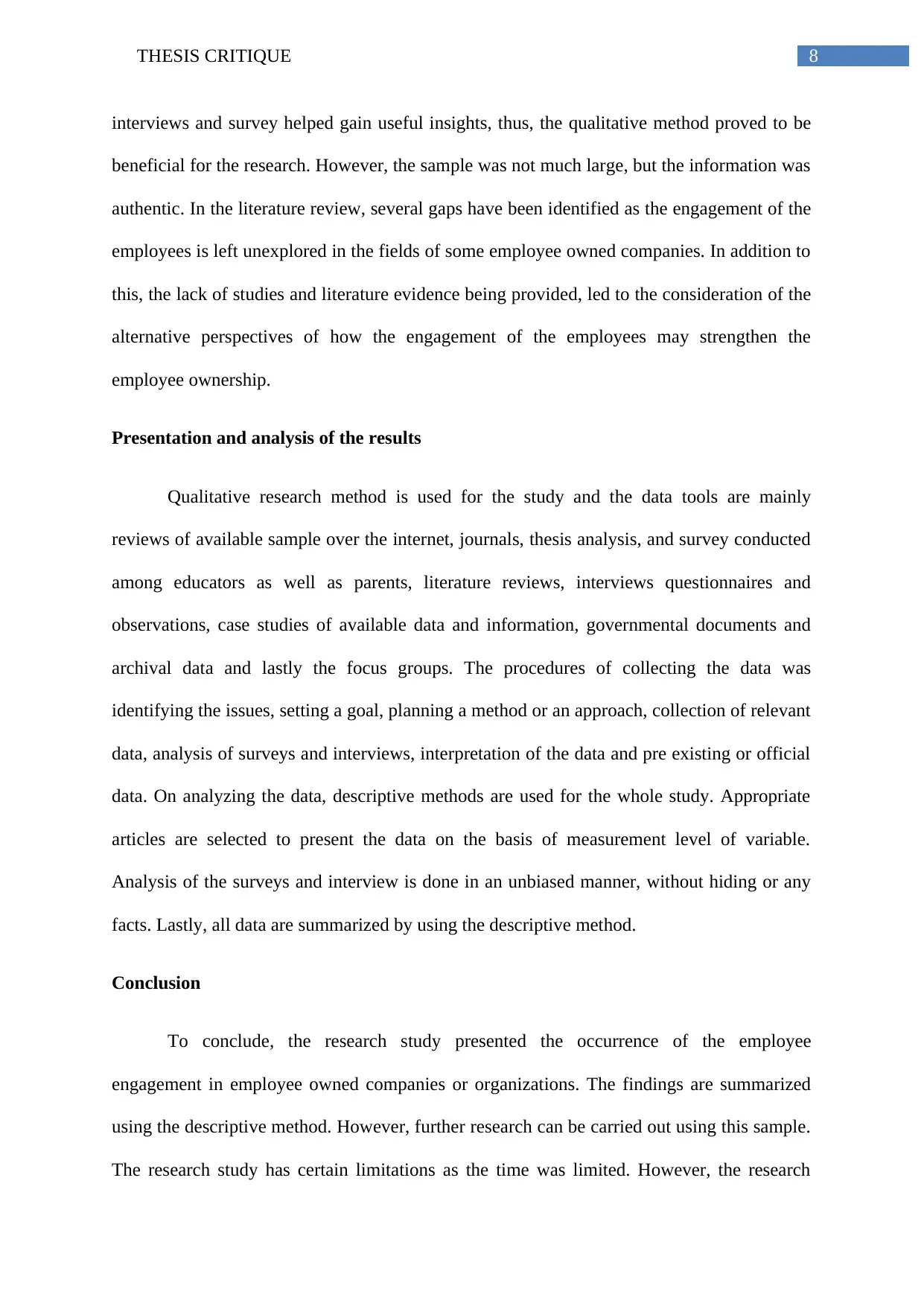
8THESIS CRITIQUE
interviews and survey helped gain useful insights, thus, the qualitative method proved to be
beneficial for the research. However, the sample was not much large, but the information was
authentic. In the literature review, several gaps have been identified as the engagement of the
employees is left unexplored in the fields of some employee owned companies. In addition to
this, the lack of studies and literature evidence being provided, led to the consideration of the
alternative perspectives of how the engagement of the employees may strengthen the
employee ownership.
Presentation and analysis of the results
Qualitative research method is used for the study and the data tools are mainly
reviews of available sample over the internet, journals, thesis analysis, and survey conducted
among educators as well as parents, literature reviews, interviews questionnaires and
observations, case studies of available data and information, governmental documents and
archival data and lastly the focus groups. The procedures of collecting the data was
identifying the issues, setting a goal, planning a method or an approach, collection of relevant
data, analysis of surveys and interviews, interpretation of the data and pre existing or official
data. On analyzing the data, descriptive methods are used for the whole study. Appropriate
articles are selected to present the data on the basis of measurement level of variable.
Analysis of the surveys and interview is done in an unbiased manner, without hiding or any
facts. Lastly, all data are summarized by using the descriptive method.
Conclusion
To conclude, the research study presented the occurrence of the employee
engagement in employee owned companies or organizations. The findings are summarized
using the descriptive method. However, further research can be carried out using this sample.
The research study has certain limitations as the time was limited. However, the research
interviews and survey helped gain useful insights, thus, the qualitative method proved to be
beneficial for the research. However, the sample was not much large, but the information was
authentic. In the literature review, several gaps have been identified as the engagement of the
employees is left unexplored in the fields of some employee owned companies. In addition to
this, the lack of studies and literature evidence being provided, led to the consideration of the
alternative perspectives of how the engagement of the employees may strengthen the
employee ownership.
Presentation and analysis of the results
Qualitative research method is used for the study and the data tools are mainly
reviews of available sample over the internet, journals, thesis analysis, and survey conducted
among educators as well as parents, literature reviews, interviews questionnaires and
observations, case studies of available data and information, governmental documents and
archival data and lastly the focus groups. The procedures of collecting the data was
identifying the issues, setting a goal, planning a method or an approach, collection of relevant
data, analysis of surveys and interviews, interpretation of the data and pre existing or official
data. On analyzing the data, descriptive methods are used for the whole study. Appropriate
articles are selected to present the data on the basis of measurement level of variable.
Analysis of the surveys and interview is done in an unbiased manner, without hiding or any
facts. Lastly, all data are summarized by using the descriptive method.
Conclusion
To conclude, the research study presented the occurrence of the employee
engagement in employee owned companies or organizations. The findings are summarized
using the descriptive method. However, further research can be carried out using this sample.
The research study has certain limitations as the time was limited. However, the research
⊘ This is a preview!⊘
Do you want full access?
Subscribe today to unlock all pages.

Trusted by 1+ million students worldwide
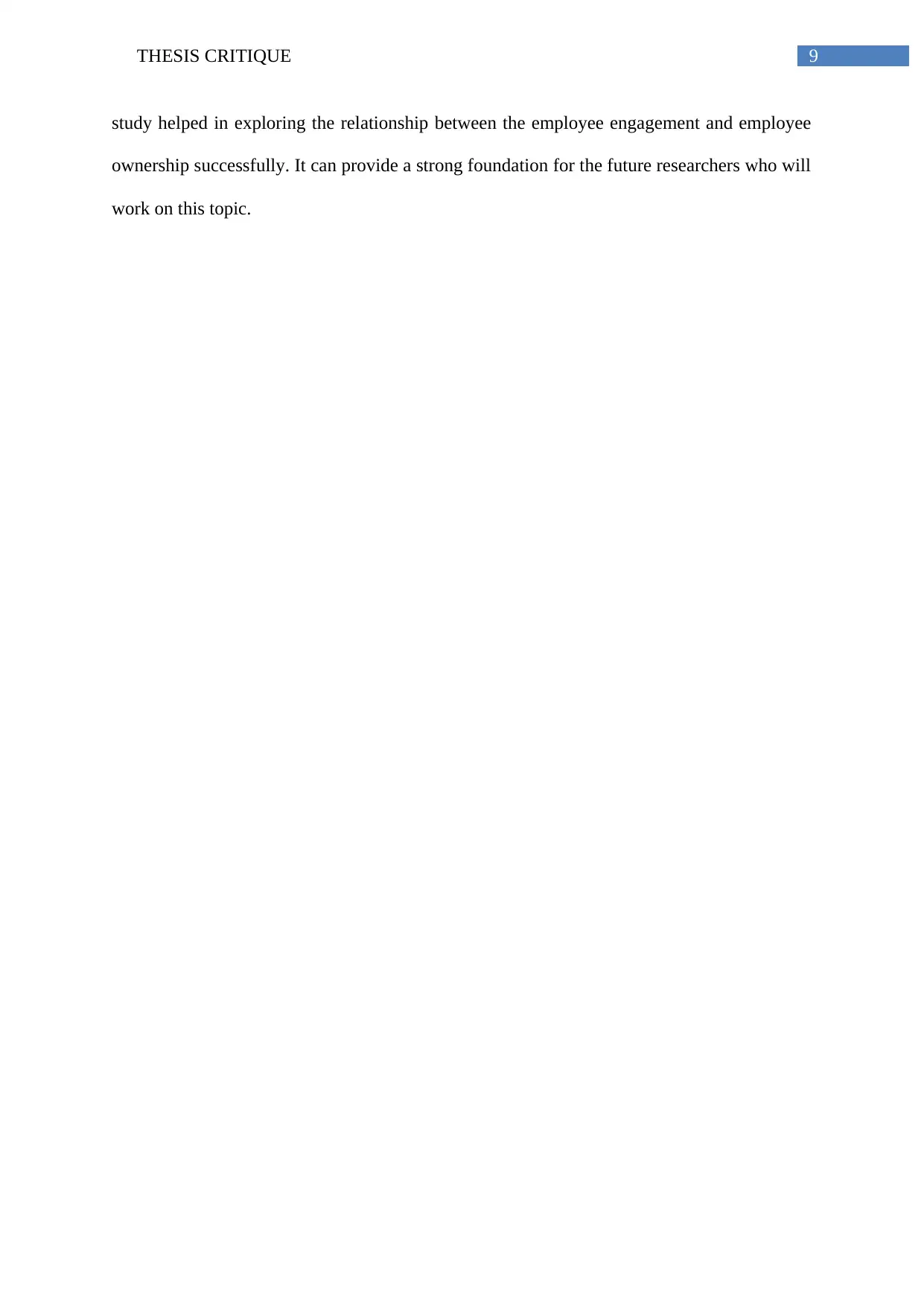
9THESIS CRITIQUE
study helped in exploring the relationship between the employee engagement and employee
ownership successfully. It can provide a strong foundation for the future researchers who will
work on this topic.
study helped in exploring the relationship between the employee engagement and employee
ownership successfully. It can provide a strong foundation for the future researchers who will
work on this topic.
Paraphrase This Document
Need a fresh take? Get an instant paraphrase of this document with our AI Paraphraser
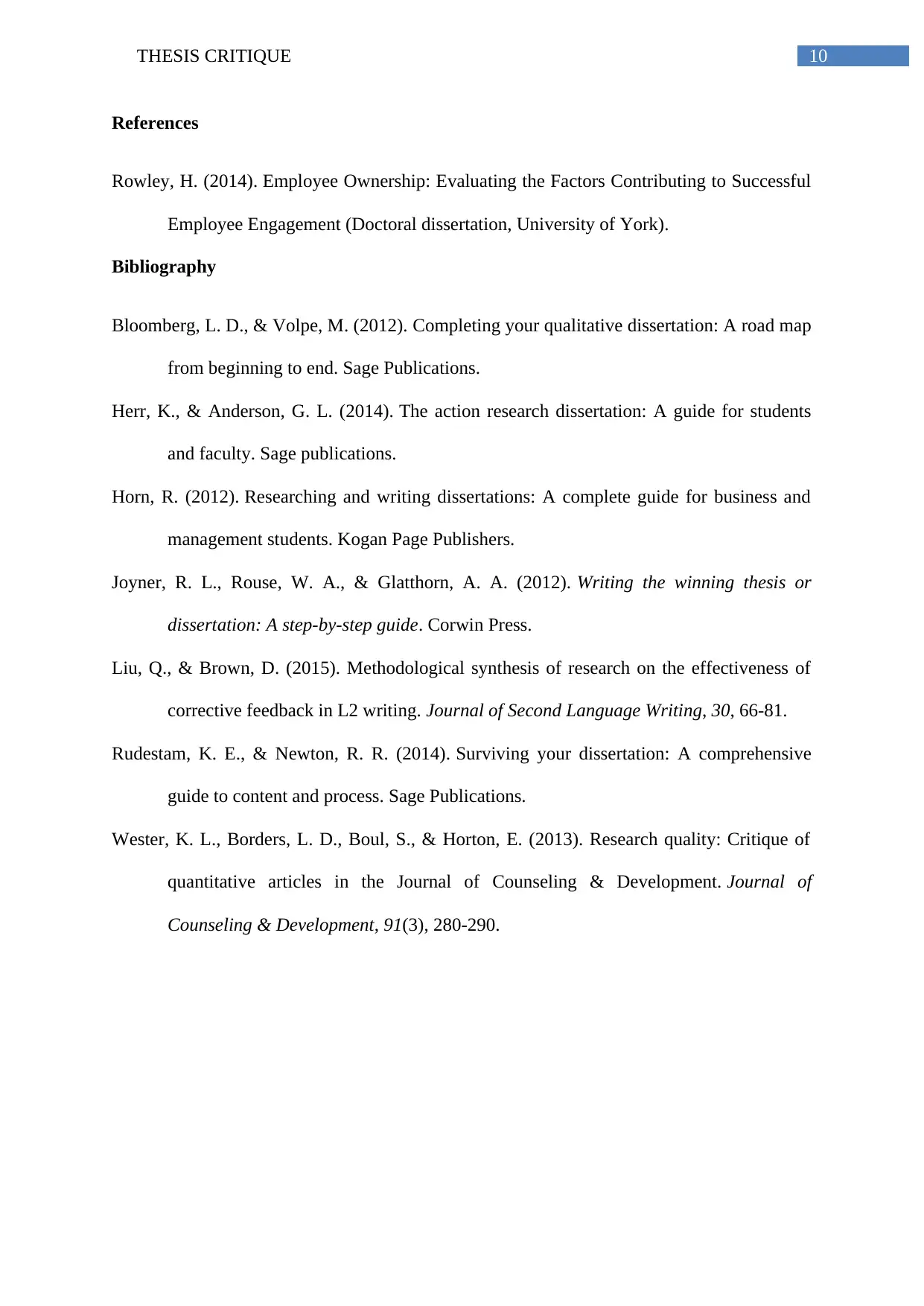
10THESIS CRITIQUE
References
Rowley, H. (2014). Employee Ownership: Evaluating the Factors Contributing to Successful
Employee Engagement (Doctoral dissertation, University of York).
Bibliography
Bloomberg, L. D., & Volpe, M. (2012). Completing your qualitative dissertation: A road map
from beginning to end. Sage Publications.
Herr, K., & Anderson, G. L. (2014). The action research dissertation: A guide for students
and faculty. Sage publications.
Horn, R. (2012). Researching and writing dissertations: A complete guide for business and
management students. Kogan Page Publishers.
Joyner, R. L., Rouse, W. A., & Glatthorn, A. A. (2012). Writing the winning thesis or
dissertation: A step-by-step guide. Corwin Press.
Liu, Q., & Brown, D. (2015). Methodological synthesis of research on the effectiveness of
corrective feedback in L2 writing. Journal of Second Language Writing, 30, 66-81.
Rudestam, K. E., & Newton, R. R. (2014). Surviving your dissertation: A comprehensive
guide to content and process. Sage Publications.
Wester, K. L., Borders, L. D., Boul, S., & Horton, E. (2013). Research quality: Critique of
quantitative articles in the Journal of Counseling & Development. Journal of
Counseling & Development, 91(3), 280-290.
References
Rowley, H. (2014). Employee Ownership: Evaluating the Factors Contributing to Successful
Employee Engagement (Doctoral dissertation, University of York).
Bibliography
Bloomberg, L. D., & Volpe, M. (2012). Completing your qualitative dissertation: A road map
from beginning to end. Sage Publications.
Herr, K., & Anderson, G. L. (2014). The action research dissertation: A guide for students
and faculty. Sage publications.
Horn, R. (2012). Researching and writing dissertations: A complete guide for business and
management students. Kogan Page Publishers.
Joyner, R. L., Rouse, W. A., & Glatthorn, A. A. (2012). Writing the winning thesis or
dissertation: A step-by-step guide. Corwin Press.
Liu, Q., & Brown, D. (2015). Methodological synthesis of research on the effectiveness of
corrective feedback in L2 writing. Journal of Second Language Writing, 30, 66-81.
Rudestam, K. E., & Newton, R. R. (2014). Surviving your dissertation: A comprehensive
guide to content and process. Sage Publications.
Wester, K. L., Borders, L. D., Boul, S., & Horton, E. (2013). Research quality: Critique of
quantitative articles in the Journal of Counseling & Development. Journal of
Counseling & Development, 91(3), 280-290.
1 out of 11
Related Documents
Your All-in-One AI-Powered Toolkit for Academic Success.
+13062052269
info@desklib.com
Available 24*7 on WhatsApp / Email
![[object Object]](/_next/static/media/star-bottom.7253800d.svg)
Unlock your academic potential
Copyright © 2020–2025 A2Z Services. All Rights Reserved. Developed and managed by ZUCOL.





